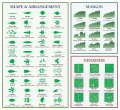Dendrology
Dendrology, from the Greek words dendron meaning "tree" and logos meaning "study," is the scientific study of trees and woody plants. This branch of botany focuses on the taxonomy, history, physical characteristics, distribution, and ecological relationships of trees and shrubs. Dendrology is crucial for understanding forest ecosystems, managing forest resources, and conserving biodiversity.
Overview[edit]
Dendrology encompasses the study of both gymnosperms (non-flowering plants such as pines and firs) and angiosperms (flowering plants that produce seeds enclosed in an ovary, such as oaks and maples). It involves identifying species, understanding their evolutionary relationships, and studying their growth, morphology, and reproduction. Dendrologists, or those who specialize in dendrology, often work closely with foresters, ecologists, and conservationists to apply their knowledge in practical settings.
Importance[edit]
The importance of dendrology extends beyond academic interest. It plays a critical role in forest management, conservation efforts, and climate change research. By understanding the characteristics and needs of different tree species, dendrologists can contribute to more effective reforestation projects, biodiversity conservation, and the sustainable management of forests. Additionally, dendrology provides insights into the historical climate conditions through the study of tree rings, a field known as dendrochronology.
Applications[edit]
- Forest Management: Dendrology aids in the selection of species for timber, pulp, and other forest products, ensuring sustainable yields and forest health.
- Conservation: Identifying and understanding the ecological requirements of tree species helps in their conservation and the restoration of degraded habitats.
- Climate Change Research: Tree rings offer valuable data on past climate conditions, helping scientists predict future climate trends and their potential impacts on ecosystems.
- Urban Planning: Knowledge of tree species is essential for urban and landscape planning, contributing to the aesthetic, environmental, and social value of urban areas.
Key Concepts[edit]
- Taxonomy: The classification of tree species based on their physical characteristics and genetic relationships.
- Morphology: The study of the form and structure of trees and woody plants.
- Ecology: The examination of how tree species interact with each other and their environment.
- Phylogenetics: The study of the evolutionary history and relationships among tree species.
Challenges[edit]
Dendrology faces several challenges, including the loss of habitats due to deforestation, climate change, and the spread of invasive species. These factors threaten the diversity and survival of tree species, making the work of dendrologists increasingly important for conservation and sustainable management efforts.
See Also[edit]
References[edit]
<references/>
Ad. Transform your life with W8MD's Budget GLP-1 injections from $75


W8MD offers a medical weight loss program to lose weight in Philadelphia. Our physician-supervised medical weight loss provides:
- Weight loss injections in NYC (generic and brand names):
- Zepbound / Mounjaro, Wegovy / Ozempic, Saxenda
- Most insurances accepted or discounted self-pay rates. We will obtain insurance prior authorizations if needed.
- Generic GLP1 weight loss injections from $75 for the starting dose.
- Also offer prescription weight loss medications including Phentermine, Qsymia, Diethylpropion, Contrave etc.
NYC weight loss doctor appointmentsNYC weight loss doctor appointments
Start your NYC weight loss journey today at our NYC medical weight loss and Philadelphia medical weight loss clinics.
- Call 718-946-5500 to lose weight in NYC or for medical weight loss in Philadelphia 215-676-2334.
- Tags:NYC medical weight loss, Philadelphia lose weight Zepbound NYC, Budget GLP1 weight loss injections, Wegovy Philadelphia, Wegovy NYC, Philadelphia medical weight loss, Brookly weight loss and Wegovy NYC
|
WikiMD's Wellness Encyclopedia |
| Let Food Be Thy Medicine Medicine Thy Food - Hippocrates |
Medical Disclaimer: WikiMD is not a substitute for professional medical advice. The information on WikiMD is provided as an information resource only, may be incorrect, outdated or misleading, and is not to be used or relied on for any diagnostic or treatment purposes. Please consult your health care provider before making any healthcare decisions or for guidance about a specific medical condition. WikiMD expressly disclaims responsibility, and shall have no liability, for any damages, loss, injury, or liability whatsoever suffered as a result of your reliance on the information contained in this site. By visiting this site you agree to the foregoing terms and conditions, which may from time to time be changed or supplemented by WikiMD. If you do not agree to the foregoing terms and conditions, you should not enter or use this site. See full disclaimer.
Credits:Most images are courtesy of Wikimedia commons, and templates, categories Wikipedia, licensed under CC BY SA or similar.
Translate this page: - East Asian
中文,
日本,
한국어,
South Asian
हिन्दी,
தமிழ்,
తెలుగు,
Urdu,
ಕನ್ನಡ,
Southeast Asian
Indonesian,
Vietnamese,
Thai,
မြန်မာဘာသာ,
বাংলা
European
español,
Deutsch,
français,
Greek,
português do Brasil,
polski,
română,
русский,
Nederlands,
norsk,
svenska,
suomi,
Italian
Middle Eastern & African
عربى,
Turkish,
Persian,
Hebrew,
Afrikaans,
isiZulu,
Kiswahili,
Other
Bulgarian,
Hungarian,
Czech,
Swedish,
മലയാളം,
मराठी,
ਪੰਜਾਬੀ,
ગુજરાતી,
Portuguese,
Ukrainian


